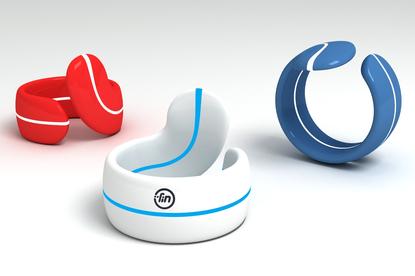Fin wearable wants to be one ring to rule them all
- 14 July, 2014 09:00

Fin is a smart ring worn on a thumb that can control other devices.
Wearable devices “should be simple, easy to wear and fashionable”, according to the creator of a ring that can control other electronic devices.
Rohildev Nattukallingal is the founder of India’s RHL Vision Technologies, and after securing $200,000 through crowdfunding platform, Indiegogo, is preparing to release his wearable Fin in January. Nattukallingal started his company in his final year at Kathir College of Engineering in Tamil Nadu, India.
He will speak on 30 July at the ADMA Global Marketing & Advertising Forum in Sydney.
Wearable devices are projected to have a major impact not only on consumers but also marketing. When wearable devices go mainstream – something analysts and tech experts say could happen by the end of this year – marketers will gain a new channel to reach customers and collect their data.
Nattukallingal told CMO he’s upbeat that the right mix of fashion and natural user experience can make wearable devices click with consumers. A fashionable design will get people to buy a wearable device, and an intuitive interface will keep them using it for a long period of time, he said.
Fin is a ring worn on the thumb and detects when the thumb touches different parts of the hand including areas of the palm and segments of fingers. It’s a natural movement that uses basic gestures people are already familiar with on smartphones, said Nattukallingal.
He added he wanted to create an easy-to-use interface that would take the stress out of using smartphones, TVs and other consumer electronics. The idea for a ring came about while observing how he held his own hand in conversations. “I figured out the thumb can access any part of the palm. It’s very flexible,” he said. “It’s simple. People already know how to use Fin.”
The startup began to research these movements and use them to build a new interface for digital devices and developed its first prototype in November. The initial device was a bit larger than Nattukallingal wanted for the final product, but the technology was working, he said.
Fin uses Bluetooth Low Energy and can connect to a variety of devices including smartphones, smart TVs and head-mounted devices. The startup is also in talks with several automobile manufacturers, said Nattukallingal.
In addition, Fin has attracted some interest from the business market, he said. Nattukallingal said he sees the ring as a perfect fit for controlling slideshows.
Devices running on the Android platform are automatically compatible with Fin. For other platforms, including Smart TVs that run a manufacturer’s custom interface, Fin is forming partnerships with the OEM.
Since it has no screen and is not constantly switched on, Fin has a longer battery life than other kinds of wearable devices, he claimed. He estimated that battery life is one to two day under continuous use, but with normal usage can last three to four days.
Fin is just one of many wearable devices coming to market. Samsung has already released multiple smartwatches, while Google has been handing out its smart glasses Google Glass to a small group of explorers and last month announced an assortment of Android-based watches.
There are also a variety of fitness bands including Fitbit, while other startups are developing clothes incorporating smart features.
Nattukallingal saw promise in smartwatches for notifications, but after testing Google Glass said he is sceptical of the format.
“I’m getting stress in my eyes while looking,” he said of the Glass experience.
In addition, while the voice recognition of Glass works well, it is not ideal in public situations where it’s not appropriate to speak commands, and the touch gestures built into Glass are not deep enough to work on their own.
Of course, Fin can be used to control Google Glass via Bluetooth, and Nattukallingal was quick to point out that the Google product’s interface weakness may well be an opportunity for a device like Fin.
Also from the speaker line-up for ADMA’s Global Forum: Why Audi of Korea is spending a quarter of its budget on mobile marketing
Adam Bender covers digital marketing and wearable computing for CMO and is the author of dystopian sci-fi novels We, The Watched and Divided We Fall. Follow him on Twitter: @WatchAdam
Follow CMO on Twitter: @CMOAustralia, take part in the CMO Australia conversation on LinkedIn: CMO Australia, join us on Facebook: https://www.facebook.com/CMOAustralia, or check us out on Google+: google.com/+CmoAu

